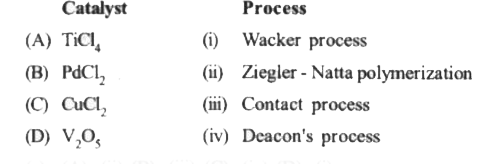A catalytic process in which the catalyst and the reactants are a part of the same phase is known as
heterogeneous catalysis
autocatalysis
enzyme catalysis
homogeneous catalysis
The correct Answer is:D
To solve the question, "A catalytic process in which the catalyst and the reactants are a part of the same phase is known as," we will analyze the options provided and determine the correct answer step by step.
1. Understanding Catalysis:
- Catalysis is a process that increases the rate of a chemical reaction by adding a substance known as a catalyst. The catalyst is not consumed in the reaction and can be recovered unchanged.
2. Identifying Types of Catalysis:
- There are two main types of catalysis based on the phase of the catalyst relative to the reactants:
- Homogeneous Catalysis: The catalyst is in the same phase (solid, liquid, or gas) as the reactants and products.
- Heterogeneous Catalysis: The catalyst is in a different phase than the reactants and products.
3. Analyzing the Options:
- Heterogeneous Catalysis: This involves different phases (e.g., solid catalyst with gaseous reactants).
- Autocatalysis: In this process, one of the products acts as a catalyst for the reaction itself.
- Enzyme Catalysis: This refers to catalysis involving biological molecules (enzymes) but does not specify the phase.
- Homogeneous Catalysis: This is when the catalyst and the reactants/products are in the same phase.
4. Conclusion:
- Since the question specifically asks for a catalytic process where the catalyst and the reactants are in the same phase, the correct answer is Homogeneous Catalysis.
Final Answer:
The correct answer is Homogeneous Catalysis.
---
- Catalysis is a process that increases the rate of a chemical reaction by adding a substance known as a catalyst. The catalyst is not consumed in the reaction and can be recovered unchanged.
- There are two main types of catalysis based on the phase of the catalyst relative to the reactants:
- Homogeneous Catalysis: The catalyst is in the same phase (solid, liquid, or gas) as the reactants and products.
- Heterogeneous Catalysis: The catalyst is in a different phase than the reactants and products.
- Heterogeneous Catalysis: This involves different phases (e.g., solid catalyst with gaseous reactants).
- Autocatalysis: In this process, one of the products acts as a catalyst for the reaction itself.
- Enzyme Catalysis: This refers to catalysis involving biological molecules (enzymes) but does not specify the phase.
- Homogeneous Catalysis: This is when the catalyst and the reactants/products are in the same phase.
- Since the question specifically asks for a catalytic process where the catalyst and the reactants are in the same phase, the correct answer is Homogeneous Catalysis.
The correct answer is Homogeneous Catalysis.
Topper's Solved these Questions
- BOOK - ARIHANT PUBLICATION JHARKHANDCHAPTER - ATOMIC STRUCTUREEXERCISE - EXAM BOOSTER FOR CRACKING EXAM66videos
ATOMIC STRUCTURE
- BOOK - ARIHANT PUBLICATION JHARKHANDCHAPTER - CONCEPT OF ATOMIC MOLECULAR AND EQUIVALENT MASSESEXERCISE - EXAM BOOSTER FOR CRACKING EXAM66videos
CONCEPT OF ATOMIC MOLECULAR AND EQUIVALENT MASSES
Similar Questions
Knowledge Check
- Question 1 - Select One or More
The process which do use catalysts are
AContact processBThermite processCOstwald's processDHaber's process - Question 2 - Select One
A catalytic poison renders the catalyst ineffective beacause :
AIt is preferentially adsorbed on the catalystBIt adsorbs the molecules of the reactantsCIt combines chemically with the catalystDIt combines chemically with one of the reactants - Question 3 - Select One
Match the catalysts to the correct process.
 AA→iii,B→i,C→ii,D→ivBA→iii,B→ii,C→iv,D→iCA→ii,B→i,C→iv,D→iiiDA→ii,B→iii,C→iv,D→i
AA→iii,B→i,C→ii,D→ivBA→iii,B→ii,C→iv,D→iCA→ii,B→i,C→iv,D→iiiDA→ii,B→iii,C→iv,D→i



